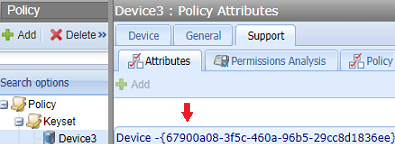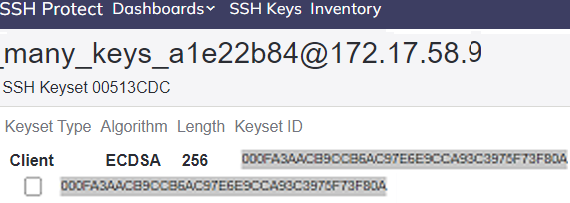POST SSH/AddUserPrivateKey
Installs a new user private key on a device. You can only add the private key when the keyset is generated inside Trust Protection Foundation or on rotated keysets. The key algorithm and length are taken from the SSH policy of the device folder. If the Algorithm is empty, the default is RSA. If the Key Size is empty, the Length is 2048.
SSH/AddUserPrivateKey API returns immediately after the key generates and inserts into the Trust Protection Foundation database. This API call does not wait until the key is actually provisioned on the device (which can take time depending on the configured Agent schedule). To track the progress of key operations, call POST SSH/KeyDetails.
Requirements
- Permissions:
Administrators must have the following permissions to create a keyset in a policy folder:
Device: View permission and Create permission.
- Keyset policy: View, Read, Write and Private Key Read permission.
The caller must have one or more of the following ownerships or permissions:
- Owner permission of any private key in this keyset.
- Read permission to the device for any key in this keyset.
- Read permission to the private key for the policy where the self-service key is present.
- Token scope: SSH:Manage
-
Headers
-
Content type: Content-Type:application/json.
- Token: The bearer access token that you received. For example, Authorization:Bearer 4MyGeneratedBearerTknz==. For more information, see Passing a bearer token in your API calls.
Parameters
|
Name |
Description |
|---|---|
|
DeviceGuid |
The GUID that identifies a device. Depending on your environment, the GUID may be expressed with or without curly braces {}. For example, {3d6b61d-1c71-4603-883f-25b8c2ceecdd}. To get the GUID, use POST SSH/KeysetDetails or the UI. For example:
|
|
Filepath |
The installation path of the key on the device. |
|
Format |
(Optional) Omit this parameter if the private key should use the policy setting. The key format: OpenSSH, SSH2, PuTTY. |
|
KeysetId |
(Optional) If not specified, new keyset will be created.
The identifier of a set of public and private key pairs. Depending on your environment, the value may be expressed with or without curly braces {}. You can get the KeysetId, from POST SSH/KeyUsage or the SSH Keyset Inventory. For example:
|
|
Passphrase |
(Optional) Passphrase to encrypt and decrypt the key. Use your company password standards or the National Institute of Standards and Technology (NIST). |
|
PolicyDN |
(Optional)
The Distinguished Name (DN) of the Policy folder where the new SSH keyset will be created. Omit this parameter the SSH keyset does not go in a Policy folder. By default, SSH keysets are not created in policies.
For more information, see |
|
Username |
Name of user specified device that will own the key. |
Returns
|
Name |
Description |
|---|---|
|
KeyId |
The identifier of newly created key. |
|
Keysetid |
The identifier for a set of public and private keys. The value is hexadecimal. If there is no private key password, the format is EncryptedPrivateKey-[unique number]. For example, EncryptedPrivateKey-3. |
|
Response |
The SSH SshWebResponse object with the operation result. If the keyset generated outside of Trust Protection Foundation, error code 6 occurs. For more information, see SSH web error codes. |
Example: Assign a keyset to a Policy folder and Device object
Request
POST https://tpp.venafi.example/vedsdk/AddUserPrivateKey Authorization:Bearer 4MyGeneratedBearerTknz==
{
"DeviceGuid":"{9063f994-bcf6-4053-b521-94a917123845}",
"Filepath":"/home/user/.ssh/user.key",
"Format":"OpenSSH",
"KeysetId":"2383F0EA3C04430C829E1FFD138C8283A1786C41",
"PolicyDN":"//VED//Policy//Keyset",
"Passphrase":"PrivateKeyPassPhrase",
"Username":"User"
} Response
HTTP/1.1 200 OK
{
"KeyId":3,
"KeysetId":"F6264A646B9B782DCCC254CCCF0917224DE2B605",
"Response":{
"Success":true
}
}

